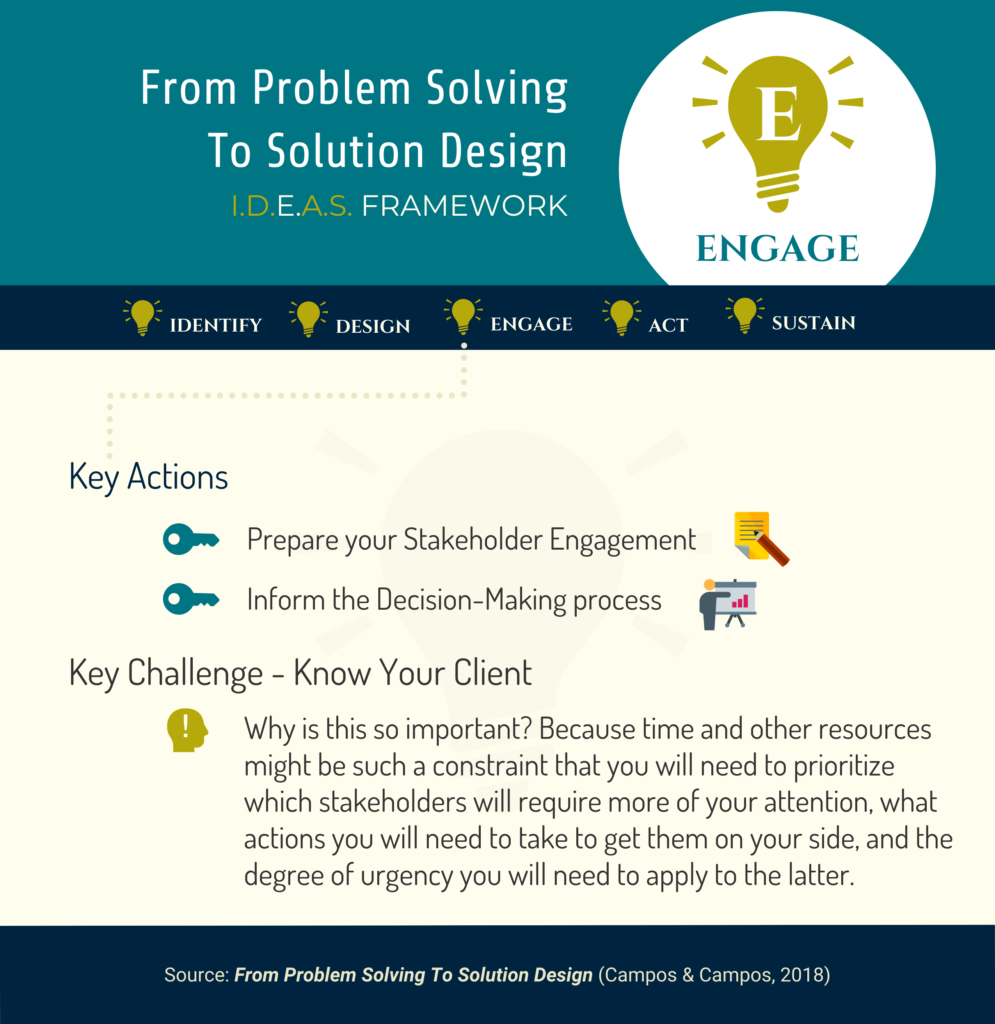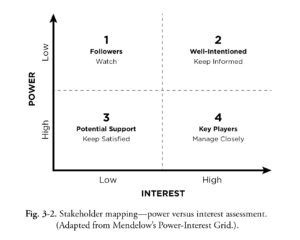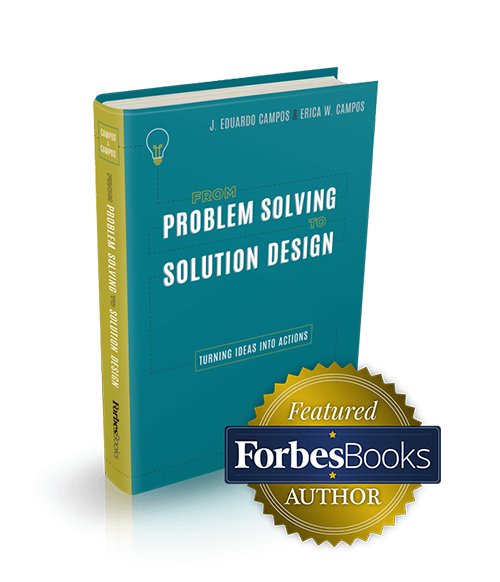In previous blog posts in this series, we’ve discussed the Identify and Design steps from our I.D.E.A.S. Framework, fully detailed in our book From Problem Solving to Solution Design (Campos & Campos, 2018). There are multiple potential challenges in each step of the I.D.E.A.S framework. I’m focusing on just one challenge per article in this series.
After Identifying the problem and Designing a solution by setting goals and assessing options, we next Engage stakeholders. We believe that any successful Solution-Design process must rely on a carefully crafted Stakeholder Engagement Plan. What do we mean by this? A Stakeholder Engagement Plan is a series of steps used to clearly identify who will be impacted by your recommended solution, either positively or negatively, and how to handle stakeholder reactions. To understand the impact and the respective mitigation measures, you will need to assess the stakeholders’ level of interest in the decision(s) to be made, their respective motivations, and any personal feelings these stakeholders might develop when faced by the effects of your recommended solution. In this way, you will be well prepared to negotiate with them.
Here are two key actions: (1) preparing your Stakeholder Engagement Plan, and (2) influencing the decision-making process.
Key challenges in the Engage step include:
- Know your client.
TIP: Determine the driving forces behind the critical decisions. - Get your stakeholders behind your recommended solution
TIP: In Rome, do like the Romans and speak their lingo. - Influence the decision-making process.
TIP: Measurement and commitment drive vital behaviors. - Give up the credit.
TIP: It is not about lone star heroes.
We will be focusing on Challenge #1: Know your client.
In this initial stage of the Solution-Design process, it is time to delve deeper into identifying and assessing the people involved in the decision-making and solution-implementation process. These people are called stakeholders, people who are involved in or are affected by your Solution-Design process.
Why is this so important? Because time and other resources might be such a constraint that you will need to prioritize which stakeholders will require more of your attention, what actions you will need to take to get them on your side, and the degree of urgency you will need to apply to the latter.
Good Solution Designers carefully map out their recommended solution’s stakeholders, and thoroughly identify their objections as well as their individual motivations to support or oppose each recommended solution. However, great Solution Designers go beyond that, taking the extra time to decipher each stakeholder’s level of interest in the decision-making process, carefully assessing which stakeholders have the power to influence it.
In order to conserve time in the process, you will need to prioritize who gets more quality attention. For example, stakeholders in the quadrant “manage closely” should receive more attention, because their support can ensure project success or failure, depending on how you manage them. This will ultimately constitute your Stakeholder Engagement Plan.
If you work in cybersecurity, this is pretty much what happens on a daily basis!
Here is a case study example from an unrelated area of expertise, demonstrating how to evaluate stakeholders:
The Problem: Devon Thompson, a project manager at a consulting firm, was tasked to help get clean water to Jamii, a community in an African country.
The complex problem is the lack of clean water in the rural village of Jamii, a poor community stricken by a severe drought for the last several years. No single organization is accountable for the issue, and neither can one tackle it alone.
The Issue: Thompson must work with what is called a “collaborative arrangement.” It is a public-private partnership, with people who have diverse backgrounds and sometimes conflicting interests, but a shared cause.
To simplify, let’s focus on the stakeholders that work for Devon’s client, the Global Sunrise Foundation (a fictitious entity used for educational purposes only). The foundation leadership has concluded that the best solution is to drill an artesian well with publicly known technology, sound technical procedures, and experienced people.
The options to get this done were set by the foundation as the following:
- Subcontract with a regional NGO that has experience in Africa.
- Contract with an international private contractor known for similar projects.
- Devon’s recommended option/solution: Transfer funding to Maji Safi, a local NGO that has previous experience in Jamii, although no experience with drilling large artesian wells. For that, the NGO would drill the well after training and accrediting its team, and developing local capabilities for any further well drilling.
Getting clean water to Jamii is a shared goal for the collaborative arrangement partners, and the foundations’ goal is to deliver on it, but the way to get there differs from stakeholder to stakeholder. Because Devon has multiple options, and he is recommending a specific one, he will need to identify who is on his side and who is not. This way, he may be able to nudge some of the stakeholders into supporting him while neutralizing others who don’t.
In addition to his initial stakeholder mapping to assess roles and support levels, Devon created a table for handling the different objections and motivations of stakeholders. He then ordered stakeholders by their impact on the actual decision-making process as well as by the impact the decision-making will have on them. “Stack Ranking” is a part of this process, grouping stakeholders with similar profiles.
In Devon’s assessment, Liliana Medrado, VP of Operations, had high power in the decision-making process as well as high interest, making her a key player. Therefore, Ms. Medrado falls into the “manage closely” quadrant in the power vs. interest grid. Devon will need to spend more time with her, carefully revisiting her motivations and objections, establishing regular communications, and spotting any change in this assessment.
Finally, Devon plans his interactions with his Stakeholder Engagement Plan. Remember, this Stakeholder Engagement Plan serves a purpose, which is to help approve your recommendation of a solution for a complex problem. The ultimate intention is to better serve your constituents. Therefore, pay attention to any bias when mapping, analyzing, and managing stakeholders. Avoid first impressions and keep digging to identify stated concerns and unvoiced motivations.
In our next article we will look at “A – Act” from our framework and review another challenge and case study.
Key Tips for the ENGAGE Step:
- Identify your key stakeholders, handle objections and match motivations, and assess the decision-making power grid.
- Prepare your Communications Plan and get your stakeholders behind your recommended solution.
- Inform and influence the decision-making process and make your decision-makers accountable for their decisions.
- Give up the credit, respect cultural differences, and celebrate success the way your decision-makers understand it.
Click here to read the Introduction to this series.
Click here to read the next post, Identify the problem.
Click here to read last week’s post.
Resources:
- Click here for more on From Problem Solving to Solution Design
- Click here for a free chapter from the book.
- Are you offering solutions that matter? Click here for a free Solution Design assessment
- Click here for additional articles, interviews and podcasts




